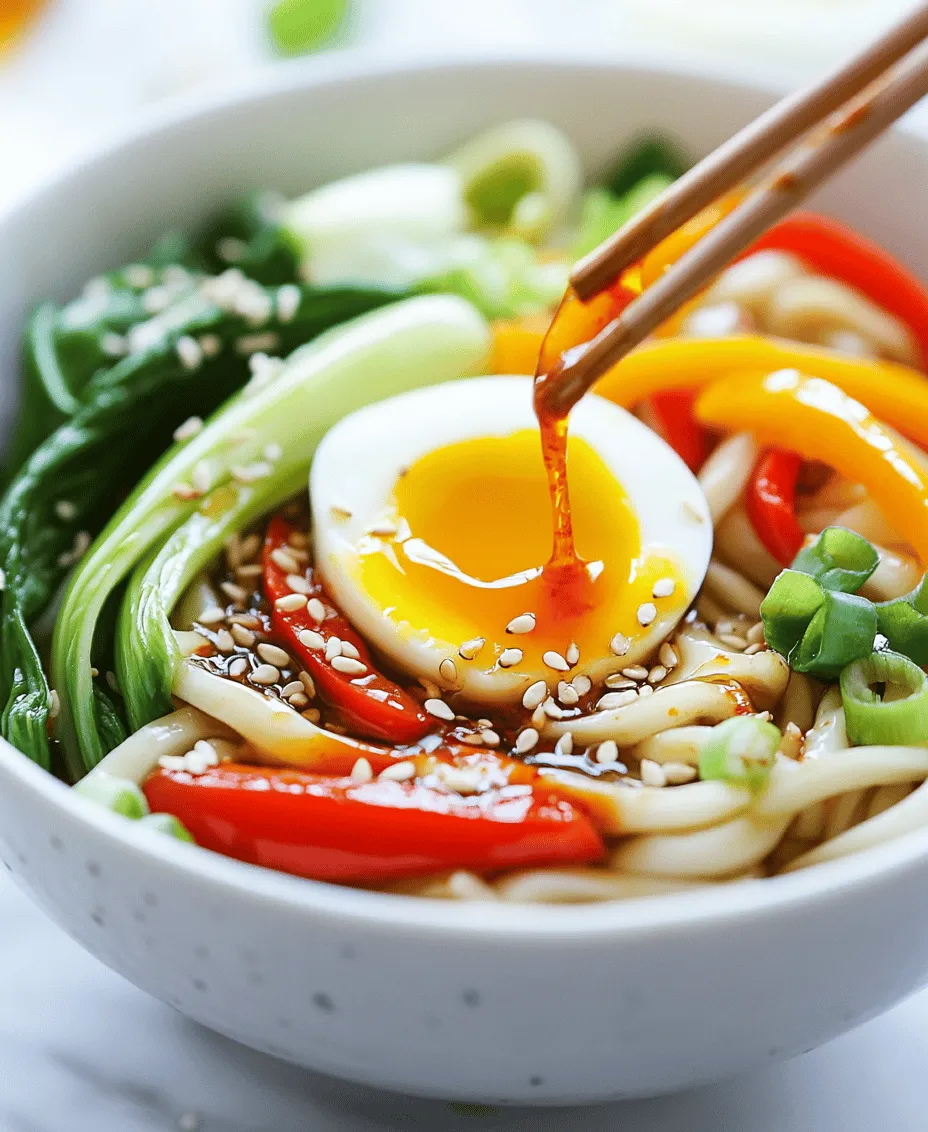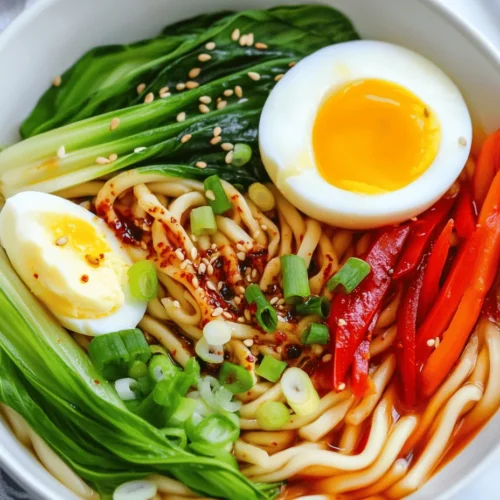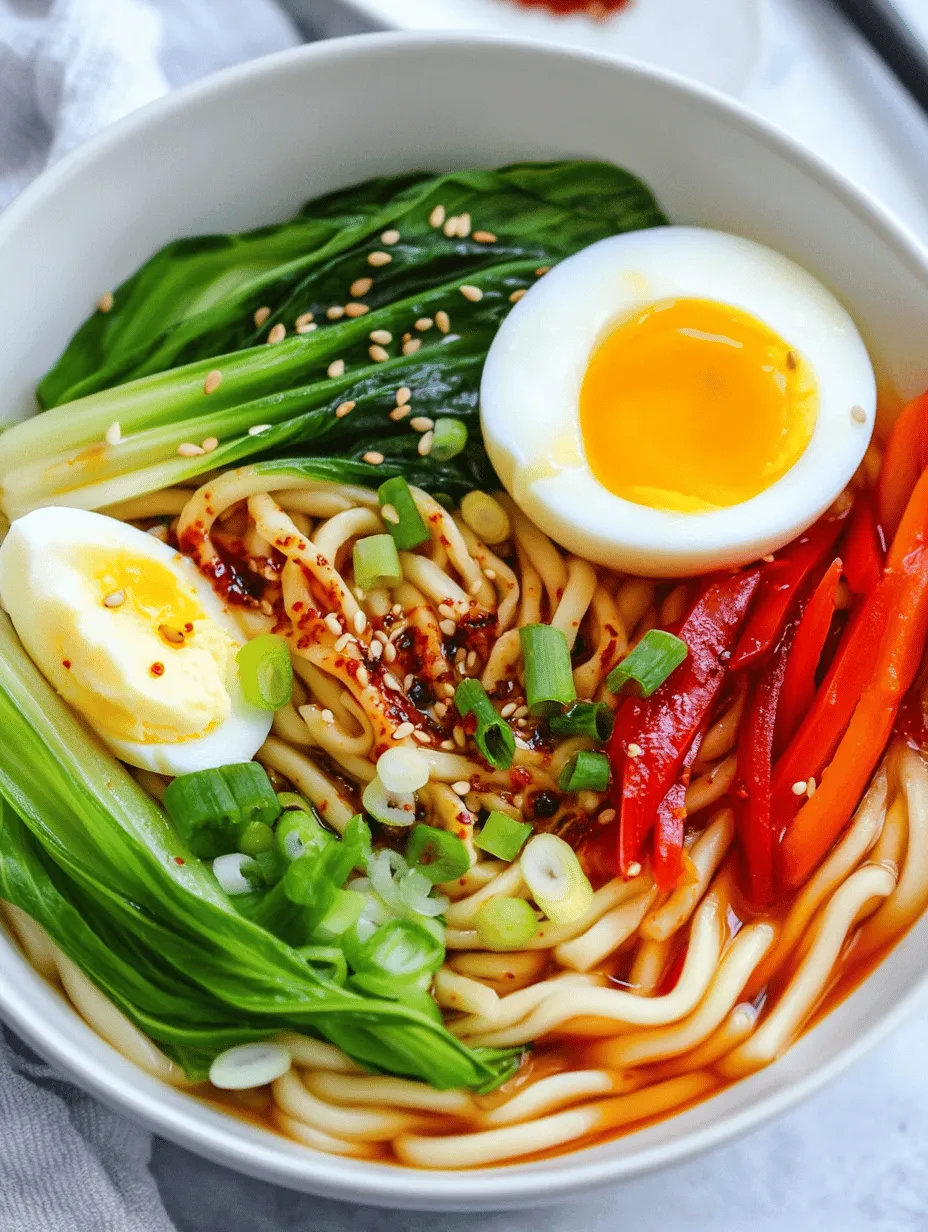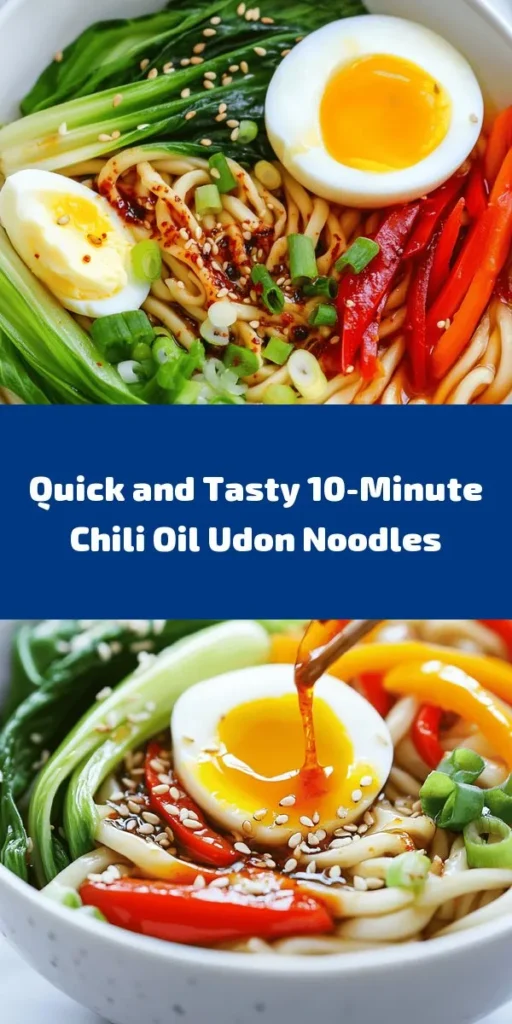Introduction
Step into the vibrant world of Asian cuisine with our quick and flavorful 10-Minute Chili Oil Udon Noodles recipe. This dish features the chewy texture of fresh udon noodles, enhanced by the warmth of chili oil and the crispness of fresh vegetables. Whether you’re looking for a satisfying weeknight dinner or a delicious lunch option, this recipe is a perfect fit for your busy lifestyle. In this article, we’ll explore the essential ingredients, preparation steps, and culinary techniques that will transform your kitchen into a haven for Asian flavors.
Udon noodles are a delightful staple in Japanese cooking, known for their thick and chewy texture. These noodles are not only versatile but also absorb flavors beautifully, making them the perfect canvas for a variety of sauces and toppings. With the right balance of ingredients and a few simple steps, you can whip up a bowl of chili oil udon noodles in just 10 minutes, making it an ideal choice for those hectic days when time is of the essence.
Understanding Udon Noodles
Definition and Origins of Udon Noodles
Udon noodles are thick, wheat-based noodles originating from Japan. They are traditionally made from just three ingredients: flour, water, and salt. The dough is kneaded, rolled out, and cut into thick strands, resulting in a chewy, hearty noodle that is perfect for soups, stir-fries, and cold dishes alike. Udon has a long history in Japanese cuisine, dating back to the 9th century, and has evolved into a beloved comfort food enjoyed across the globe.
Udon can be served in various ways, including in hot broths, cold with dipping sauces, or stir-fried with vegetables and proteins. The noodles’ neutral flavor allows them to pair well with a wide range of ingredients, making them a versatile addition to any meal.
Nutritional Benefits of Udon Noodles
Besides their delightful texture and taste, udon noodles offer several nutritional benefits. They are primarily made from whole wheat flour, providing a good source of carbohydrates for energy. Udon noodles are low in fat and contain no cholesterol, making them a heart-healthy option when prepared with wholesome ingredients. Additionally, they can be enriched with various toppings such as vegetables, proteins, and sauces, enhancing their nutritional profile and making for a balanced meal.
While udon noodles are not gluten-free, they can be enjoyed by those who tolerate gluten as part of a varied diet. Pairing them with fresh vegetables and lean proteins can create a nutritious dish that satisfies both hunger and health-conscious goals.
Different Types of Udon Noodles Available
When it comes to udon noodles, there are several varieties to choose from. Fresh udon noodles are commonly found in Asian grocery stores and are typically sold in vacuum-sealed packages. These noodles are soft and have a delightful chewiness that makes them ideal for quick cooking.
Dried udon noodles are another option, which can be stored for longer periods and offer convenience for those who may not have access to fresh noodles. They require a longer cooking time but can yield delicious results when prepared correctly.
Some variations of udon include:
– Yaki Udon: Stir-fried udon noodles often served with vegetables and proteins, showcasing the versatility of the noodle.
– Nabeyaki Udon: A hot pot dish where udon noodles are cooked in a rich broth, usually topped with tempura and vegetables.
– Cold Udon: Served chilled with a dipping sauce, perfect for hot summer days.
Whichever type you choose, udon noodles are sure to bring a satisfying experience to your meal.
Key Ingredients for Chili Oil Udon Noodles
Fresh Udon Noodles
The star of this dish, fresh udon noodles, are the foundation for your chili oil udon noodles recipe. Their thick, chewy texture provides a satisfying bite that pairs perfectly with the rich flavors of the chili oil and accompanying ingredients. Opt for fresh udon noodles if possible, as they cook quickly and yield the best results. If fresh noodles are not available, dried udon noodles can be used, but be sure to follow the package instructions for cooking times.
Chili Oil: Types and Flavor Profiles
Chili oil is the key ingredient that gives this dish its signature flavor and heat. It’s important to choose the right type of chili oil to achieve the desired spice level and taste. There are several varieties of chili oil, each with its unique flavor profiles:
– Sichuan Chili Oil: Infused with spices and often featuring a fragrant aroma, this oil adds a complex depth of flavor to dishes.
– Thai Chili Oil: Typically sweeter and less spicy, this oil can add a different balance to your udon noodles.
– Homemade Chili Oil: Making your own chili oil allows you to customize the heat level and flavors by adjusting the type of chili flakes and additional spices used.
Regardless of the type you choose, chili oil will elevate your udon noodles and create a mouthwatering experience.
The Role of Soy Sauce and Sesame Oil
Soy sauce and sesame oil are essential condiments in this dish that complement the flavors of chili oil. Soy sauce provides umami richness and saltiness, enhancing the overall taste of the udon noodles. It is a staple in Asian cooking and works harmoniously with the other ingredients.
Sesame oil, on the other hand, adds a nutty flavor and aromatic quality to the dish. When combined with soy sauce and chili oil, it creates a balanced and flavorful sauce that clings beautifully to the udon noodles. A drizzle of sesame oil at the end of cooking can also enhance the fragrance and taste of the dish.
Aromatics: Garlic and Ginger
To truly elevate the flavors in your 10-Minute Chili Oil Udon Noodles, incorporating aromatics such as garlic and ginger is essential. Both ingredients are staples in Asian cuisine, known for their robust flavors and health benefits.
Garlic adds a pungent, savory element, while ginger contributes a warm, slightly spicy note. Together, they create a flavorful base that enhances the overall dish. Sautéing these aromatics at the beginning of the cooking process allows their flavors to infuse into the oil, creating a rich foundation for the udon noodles.
Vegetable Selection: Choosing Fresh and Crisp Options
The addition of fresh vegetables not only enhances the nutritional value of your chili oil udon noodles but also adds color and texture to the dish. When selecting vegetables, aim for crisp and vibrant options, such as:
– Bell Peppers: Enhance the dish with sweetness and a pop of color.
– Snap Peas: Add crunch and freshness.
– Carrots: Offer a slight sweetness and vibrant color when julienned.
– Broccoli or Bok Choy: Provide a hearty texture and additional nutrients.
These vegetables complement the udon noodles beautifully and can be easily sautéed for a quick cook time. Feel free to mix and match vegetables based on your preferences or what you have on hand.
The Importance of Green Onions
Green onions, or scallions, play a vital role in this recipe as both an ingredient and a garnish. Their mild onion flavor and crisp texture add freshness to the dish, balancing the richness of the chili oil and other seasonings. When preparing your udon noodles, be sure to slice the green onions thinly, using both the green and white parts for maximum flavor.
Additionally, a sprinkle of green onions on top of your finished dish adds a burst of color and an aromatic finish that enhances the overall presentation.
Optional Topping: Soft-Boiled Egg
For those looking to add a touch of indulgence to their chili oil udon noodles, a soft-boiled egg can be a delightful optional topping. The creamy yolk adds richness to the dish and pairs beautifully with the spicy flavors. To prepare a soft-boiled egg, simply boil the egg for about 6-7 minutes, then transfer it to ice water to stop the cooking process. Once cool, peel and slice in half before placing it atop the finished udon noodles.
Step-by-Step Preparation of 10-Minute Chili Oil Udon Noodles
Cooking Udon Noodles: A Quick Guide
To begin your culinary adventure with 10-Minute Chili Oil Udon Noodles, start by cooking the udon noodles. If you’re using fresh noodles, they typically require just a few minutes in boiling water. Bring a pot of water to a rolling boil, add the noodles, and cook according to the package instructions (usually around 2-3 minutes). Stir occasionally to prevent sticking.
Once cooked, drain the noodles and rinse them under cold water to stop the cooking process and remove excess starch. This step ensures that your udon noodles remain firm and chewy, ready to soak up the delicious flavors of the dish.
If you are using dried udon noodles, follow the package directions for cooking times, as they may require longer than fresh noodles.
Creating the Flavor Base with Chili Oil
Once your udon noodles are cooked and set aside, it’s time to build the flavor base. In a large skillet or wok, heat a generous amount of chili oil over medium heat. For additional flavor, you can combine the chili oil with a splash of sesame oil to create a rich and aromatic cooking medium.
As the oil heats up, it’s important to keep an eye on the temperature to prevent burning. A medium heat will allow the oil to release its flavors without becoming too hot. Once the oil is shimmering, it’s time to add the minced garlic and ginger.
Sautéing Aromatics for Maximum Flavor
Add the minced garlic and ginger to the hot oil, stirring constantly for about 30 seconds, or until the aromas are released. Be cautious not to let the garlic brown too much, as it can develop a bitter taste. This step enhances the overall flavor profile of your udon noodles, and the fragrant aroma will fill your kitchen.
Next, add your selected vegetables to the skillet, sautéing them until they’re tender yet crisp. Depending on the vegetables you choose, this may take just a few minutes. Stir frequently to ensure even cooking, allowing the vibrant colors and flavors to meld together.
With the vegetables slightly softened and the aromatics fragrant, it’s time to incorporate the cooked udon noodles into the skillet. Toss everything together, ensuring the noodles are well-coated with the chili oil and mixed with the sautéed vegetables.
Incorporate a splash of soy sauce and a drizzle of sesame oil to enhance the flavors further. Stir-fry the mixture for an additional minute, allowing the noodles to absorb the flavors of the sauce while becoming heated through.
By following these steps, you’ll create a bowl of 10-Minute Chili Oil Udon Noodles that is not only quick to make but also bursting with flavor. The combination of chewy udon noodles, aromatic garlic and ginger, fresh vegetables, and the spiciness of chili oil will leave your taste buds craving more.
Stay tuned for the next part of this recipe, where we’ll delve deeper into finishing touches and tips for making this dish your own.

Incorporating Vegetables: Best Practices
Integrating vegetables into your 10-Minute Chili Oil Udon Noodles not only enhances the dish’s nutritional value but also introduces a variety of textures and flavors. Here are some best practices to ensure your vegetables shine in this quick meal:
1. Choose Quick-Cooking Vegetables: Opt for vegetables that cook rapidly. Ideal choices include bell peppers, snap peas, bok choy, and baby spinach. These can be added directly to the boiling water with the noodles for a seamless cooking process.
2. Prep Ahead: Wash, chop, and store your vegetables in the refrigerator before cooking. This saves time during the cooking process and ensures that the vegetables remain fresh.
3. Add in Stages: If you are using a variety of vegetables, consider their cooking times. Harder vegetables like carrots should be added first, followed by softer ones like leafy greens, which only need a minute or two to wilt.
4. Maintain Color and Crunch: Avoid overcooking your vegetables. Aim for a bright color and a slight crunch to preserve their flavor and nutritional benefits.
Combining Noodles and Seasoning: The Final Toss
Once your udon noodles and vegetables are cooked, it’s time to bring everything together. Follow these steps for the perfect final toss:
1. Drain and Rinse: After cooking the noodles and vegetables, drain them well and rinse under cold water briefly to stop the cooking process. This also helps to separate the noodles, preventing them from clumping.
2. Heat the Oil: In a large skillet or wok, heat a tablespoon of chili oil over medium heat. This will enhance the flavors of the dish and give it that signature heat.
3. Add the Noodles and Vegetables: Once the oil is hot, add the drained noodles and vegetables to the skillet. Toss gently to coat everything evenly with the chili oil.
4. Season Generously: Sprinkle in soy sauce, sesame oil, and any additional seasonings you prefer. Toss everything together, ensuring that the noodles and vegetables are well-coated. This final toss is crucial for flavor distribution.
5. Taste and Adjust: Before serving, taste your noodles. You may want to add more chili oil for heat, soy sauce for saltiness, or a splash of vinegar for tanginess.
Plating and Garnishing for Visual Appeal
An appealing presentation can turn a simple dish into an unforgettable experience. Here’s how to plate your Chili Oil Udon Noodles beautifully:
1. Choose the Right Bowl: Select a wide, shallow bowl that allows the noodles to spread out. This gives a beautiful view of the colorful vegetables and garnishes.
2. Twirl the Noodles: Using tongs, twirl a serving of noodles into a neat mound in the center of the bowl. This technique adds height and visual interest.
3. Layer the Vegetables: Arrange your vegetables artistically on top of the noodles. This not only enhances the aesthetic but also showcases the variety of ingredients you’ve used.
4. Garnish Thoughtfully: Sprinkle sesame seeds, chopped scallions, and fresh herbs like cilantro or basil on top. A drizzle of additional chili oil can also add a glossy finish and more depth of flavor.
5. Serve Immediately: Udon noodles are best enjoyed fresh, so serve immediately after plating to ensure they retain their texture and warmth.
Flavor Variations and Customizations
One of the joys of cooking is the ability to customize recipes to fit your taste preferences. Here are some ways to vary your Chili Oil Udon Noodles:
Spice Levels: Adjusting the Heat of Your Dish
If you love heat, consider these options:
– More Chili Oil: Add additional chili oil during cooking for a bolder flavor.
– Fresh Chilies: Incorporate sliced fresh chilies, such as Thai bird chilies or jalapeños, for an extra kick.
– Chili Paste: A spoonful of chili garlic paste can add both heat and complexity.
Vegetable Substitutions: A Guide to Alternatives
Feel free to switch up the vegetables based on what you have on hand:
– Mushrooms: Shiitake or button mushrooms add a savory umami flavor.
– Zucchini: Thinly sliced zucchini cooks quickly and adds a light texture.
– Carrots: Julienne or thinly sliced carrots provide sweetness and crunch.
Protein Additions: Tofu, Chicken, and More
To make your meal heartier, consider adding protein:
– Tofu: For a vegetarian option, pan-fry or bake tofu cubes until golden before adding them to the noodles.
– Chicken: Sauté sliced chicken breast or thighs in the skillet before adding noodles and vegetables for a meaty addition.
– Shrimp: Quick-cooking shrimp can be added during the last minute of cooking for a seafood twist.
Vegan Options: Ensuring a Plant-Based Meal
For those following a vegan diet, ensure all ingredients align with plant-based standards:
– Soy Sauce: Use a gluten-free soy sauce if needed, as some brands contain wheat.
– Chili Oil: Check that your chili oil is made without animal-derived ingredients.
Serving Suggestions and Presentation Ideas
To elevate your dining experience, consider these suggestions for serving your Chili Oil Udon Noodles:
Ideal Pairings: What to Serve with Chili Oil Udon Noodles
Complement your udon noodles with side dishes that enhance the meal:
– Spring Rolls: Crispy vegetable spring rolls provide a delightful crunch.
– Asian Slaw: A refreshing slaw made with cabbage and carrots dressed in a sesame vinaigrette adds a fresh contrast.
– Miso Soup: A light miso soup can serve as a comforting side, balancing the spiciness of the noodles.
Plating Techniques for an Eye-Catching Meal
– Layering: Create depth by layering different components. Place a portion of noodles on the bottom, followed by vegetables and protein on top.
– Color Contrast: Use vibrant vegetables like red bell peppers and green scallions to create a visually appealing contrast.
Creating a Complete Meal with Sides
To create a full meal experience, consider serving your udon noodles with:
– Steamed Edamame: A protein-packed appetizer that’s simple to prepare and adds a pop of color.
– Pickled Vegetables: Serve a small side of pickled radishes or cucumbers for a tangy bite that cuts through the richness of the noodles.
Nutritional Value of Chili Oil Udon Noodles
Understanding the nutritional aspects of your meal can help you make informed choices. Here’s a breakdown of the nutrition in your Chili Oil Udon Noodles:
Caloric Breakdown of Ingredients
The caloric content of your dish will depend on the specific ingredients and quantities used. Typically, a serving of udon noodles contains around 200-300 calories, while the vegetables and added proteins contribute to the total caloric value.
Health Benefits of the Components
– Udon Noodles: Made from wheat flour, udon noodles are a good source of carbohydrates, providing energy for your day.
– Vegetables: Each vegetable adds its own set of vitamins and minerals. For instance, bell peppers are rich in vitamin C, while leafy greens offer iron and fiber.
– Chili Oil: The oil not only adds flavor but also contains capsaicin, known for its metabolism-boosting properties.
Dietary Considerations: Gluten-Free and Vegan Adaptations
– Gluten-Free: Substitute udon noodles with gluten-free rice noodles or zucchini noodles to keep the dish gluten-free.
– Vegan Adaptations: Ensure all sauces and oils are vegan-friendly to maintain the integrity of the dish for plant-based diets.
Conclusion
In just 10 minutes, you can whip up a delicious bowl of Chili Oil Udon Noodles that is not only quick to prepare but also packs a punch of flavor and nutrition. This dish is versatile, allowing for creativity in ingredient selection and cooking methods. Whether you choose to stick to the original recipe or make it your own, these udon noodles are sure to become a favorite in your culinary repertoire. Enjoy this delightful meal and embrace the rich flavors of Asian cuisine. The simplicity of preparation combined with the ability to customize makes this dish a perfect addition to your weeknight dinner rotation. So gather your ingredients, unleash your creativity, and savor the experience of making and enjoying your own bowl of Chili Oil Udon Noodles!



